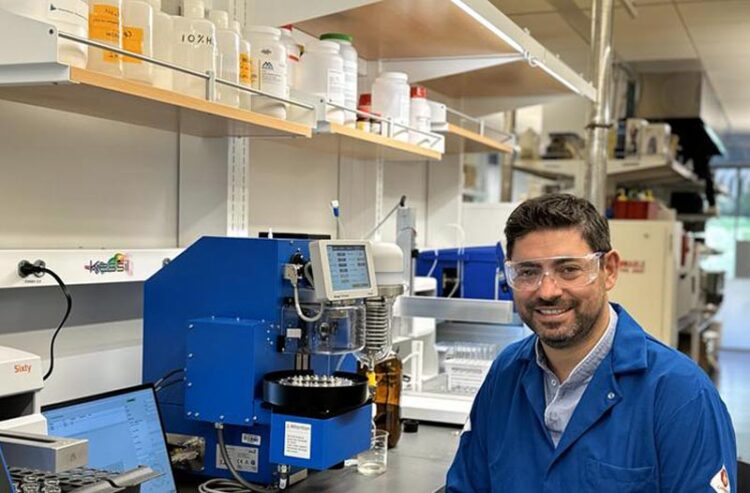Targeting failure with new polymer technology to enhance sustainability

Associate Professor Yoan Simon in his lab at Arizona State University
Credit: Yoan Simon
Sustainability is a complex problem with many different players and influenced by policies, society, and technical perspective.
We are reminded every day in the media of the unnecessary amount of waste that we are generating with pervasive pictures of plastic garbage patches floating in the oceans or stranded on our beaches.
Scientists within ASU’s School of Molecular Sciences (SMS) and the Biodesign Institute’s Center for Sustainable Macromolecular Materials and Manufacturing (SM3) are pursuing a multi-pronged approach towards a more circular economy, with projects focused on biosourcing, recycling, water purification, or carbon capture to name a few.
One obvious strategy to limit the vast amount of materials wasted is to reduce the need to produce plastics worldwide. “That is easier said than done!” says associate professor Yoan Simon of ASU’s SMS and SM3. “However, the antidote could simply be to prolong the lifespan of parts.”
From tethers in backpacks to container lids, we are surrounded by parts that must withstand thousands of opening and closing cycles. Likewise, bike and football helmets must withstand repeated impacts and maintain a given level of protection without failing.
As the saying goes, “If it ain’t broke, don’t fix it! But how exactly does it break?” asks Simon. “What happens when you throw a projectile at a material supposed to absorb shocks repeatedly?”
A collaborative team co-led by the Simon research group at ASU in collaboration with the National Institute of Standards and Technology (NIST), the University of Southern Mississippi, Rensselaer Polytechnic Institute, and the Army Corps of Engineers have developed a new material that provides new information about how materials respond to impact at high velocity.
The study, just published in Nature Communications, demonstrates how a polymer containing mechanophores -molecules that illuminate under large mechanical force- can visually record the response of the material to high-speed projectile impacts. Notably, the mechanophores captured subsurface distortions in the material, information that was previously impossible to access. By integrating molecular-level interactions with advanced imaging techniques, the scientists can now visualize the formation of Mach cones-acoustic waves that travel faster than the speed of sound in the material.
Simply speaking, they have introduced molecular reporters that light up like a Christmas tree (or in this case a Mach cone) when the speed of the projectile exceeds the speed of sound in the material, similar to the boom that occurs when a jet fighter goes supersonic.
Simon, whose group has spent decades working on introducing luminescent or color-changing probes in materials to understand how materials respond to mechanical events, is buoyant about this collaborative piece of work. “For years, many groups have shown activation in materials whose deformation was visible to the naked eye, limiting the applicability of these molecular probes,” explains Simon. “What’s really novel about this study is that it provides us with a unique tool to look at what happens deep inside the material. We get to see how waves propagate in the material upon impact.”
This work combined some heavy computational efforts with advanced analytical methods developed at NIST to evaluate the aftermaths of impact.
“In simple terms, we used a microscopic gun to shoot microprojectiles at materials and use ultrafast cameras and advanced microscopy to get some critical information about the energy absorbed and how it is transmitted through the material,” says Simon. Beyond this work, these probes could provide deeper insights into various impulsive events, including mild traumatic brain injuries, cold spray additive manufacturing, or hypervelocity impacts in space.
“Edwin Chan and his team (NIST) have been instrumental in getting this project together,” explains Simon. “He and I were classmates in grad school at the University of Massachusetts, Amherst, many moons ago and that friendship has enabled this project to see the light of day.”
Journal: Nature Communications
DOI: 10.1038/s41467-024-52663-1
Method of Research: Experimental study
Subject of Research: Not applicable
Article Title: Mechanochemically Responsive Polymer Enables Shockwave Visualization
Article Publication Date: 7-Oct-2024
All latest news from the category: Materials Sciences
Materials management deals with the research, development, manufacturing and processing of raw and industrial materials. Key aspects here are biological and medical issues, which play an increasingly important role in this field.
innovations-report offers in-depth articles related to the development and application of materials and the structure and properties of new materials.
Newest articles

NASA: Mystery of life’s handedness deepens
The mystery of why life uses molecules with specific orientations has deepened with a NASA-funded discovery that RNA — a key molecule thought to have potentially held the instructions for…

What are the effects of historic lithium mining on water quality?
Study reveals low levels of common contaminants but high levels of other elements in waters associated with an abandoned lithium mine. Lithium ore and mining waste from a historic lithium…

Quantum-inspired design boosts efficiency of heat-to-electricity conversion
Rice engineers take unconventional route to improving thermophotovoltaic systems. Researchers at Rice University have found a new way to improve a key element of thermophotovoltaic (TPV) systems, which convert heat…



